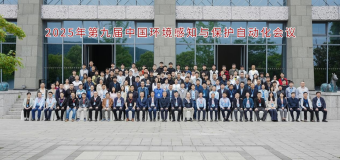
Group Photo Taken with Attendees of the Conference
From May 9 to 11, the 9th China Conference on Environmental Perception and Protection Automation was successfully held in Xuzhou. The event was jointly organized by China University of Mining and Technology and the Technical Committee on Environmental Perception and Protection Automation of the Chinese Association of Automation, and hosted by the School of Information and Control Engineering of CUMT. Centered on the theme “Intelligent Ecology for a Greener Future,” the conference brought together over 150 experts and scholars from across the country to explore the latest developments in the field of environmental perception and protection automation.
At the opening ceremony, Vice President of CUMT Bian Zhengfu and Qiao Junfei, Chair of the Technical Committee and Deputy Secretary of the Party Committee of Beijing University of Technology, delivered welcome remarks. The ceremony was presided over by Wang Xuesong, Dean of the School of Information and Control Engineering.
The conference featured keynote addresses by four distinguished scholars: Professor Tong Shaocheng, President of Liaoning University of Technology; Professor Chen Junlong, Vice President of the Chinese Association of Automation and professor at South China University of Technology; Professor Yue Dong from Nanjing University of Posts and Telecommunications; and Professor Chai Li from Zhejiang University. These experts presented leading-edge research and insights in their respective fields.
The conference included five thematic forums, systematically presenting the latest advances in the domain of environmental perception. More than 30 experts and scholars delivered focused presentations, sharing their most recent research outcomes and academic experiences, while engaging in in-depth discussions with attendees.
As a high-level academic platform in China’s environmental automation sector, this year’s conference effectively promoted interdisciplinary integration between fundamental theories—such as intelligent perception and automated detection, machine learning and pattern recognition, information processing and autonomous control, dynamic optimization and intelligent decision-making—and practical applications including environmental monitoring, process control in environmental governance, and optimization and decision-making for environmental management. Experts in attendance unanimously agreed that the conference played a significant role in fostering collaborative innovation across academia, industry, and research institutions, and that it holds great practical value for advancing ecological civilization and achieving China’s dual carbon goals.